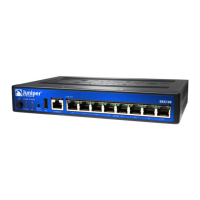Resetting the Configuration File When the SRX100 Services Gateway Is Inaccessible
This topic includes the following sections:
■ Using the Reset Config Button on the SRX100 Services Gateway on page 85
■ Changing the Reset Config Button Behavior on the SRX100 Services
Gateway on page 86
Using the Reset Config Button on the SRX100 Services Gateway
If a configuration fails or denies management access to the services gateway, you
can use the Reset Config button to restore the device to the factory default
configuration or a rescue configuration. For example, if someone inadvertently
commits a configuration that denies management access to a services gateway, you
can delete the invalid configuration and replace it with a rescue configuration by
pressing the Reset Config button.
NOTE: The Reset Config button is recessed to prevent it from being pressed
accidentally.
The rescue configuration is a previously committed, valid configuration. You must
have previously set the rescue configuration through the J-Web interface or the CLI.
To press the Reset Config button, insert a small probe (such as a straightened paper
clip) into the pinhole on the front panel.
■ By default, pressing and quickly releasing the Reset Config button loads and
commits the rescue configuration through the J-Web interface or the CLI. The
Status LED glows amber during this time. For details, see the JUNOS CLI User
Guide.
■ By default, pressing and holding the Reset Config button for 15 seconds or
more—until the Status LED glows amber—deletes all configurations on the device,
including the backup configurations and rescue configuration, and loads and
commits the factory configuration. For details about factory default settings, see
the JUNOS Software Administration Guide.
Related Topics ■ Changing the Reset Config Button Behavior on the SRX100 Services Gateway on
page 86
■ Monitoring the SRX100 Services Gateway Chassis Using the CLI on page 79
■ Monitoring the SRX100 Services Gateway Components Using LEDs on page 81
■ Monitoring the SRX100 Services Gateway Using Chassis Alarm Conditions on
page 83
■ Monitoring the SRX100 Services Gateway Power System on page 84
■ Juniper Networks Technical Assistance Center on page 87
Resetting the Configuration File When the SRX100 Services Gateway Is Inaccessible ■ 85
Chapter 14: Monitoring the SRX100 Services Gateway

